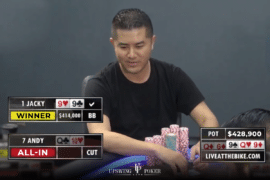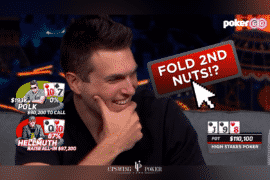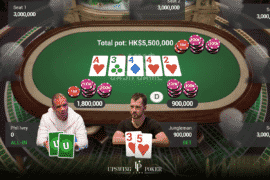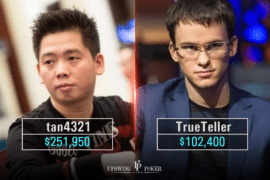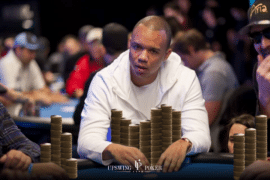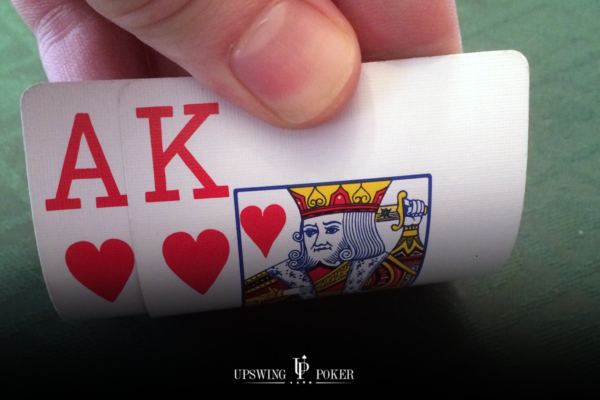
How a Poker Boss Bluffs with Ace-King (Analysis)
What should I do when I have ace-king and miss the flop?
This is one of the most common questions asked by poker players who are just starting out.
If you’re an experienced player, you know that there’s a big problem with that question: a lack of details. The positions, preflop action, flop, stack sizes…all of these crucial details and more are missing.
And while it is possible to answer the question generally (as Doug Polk did here on this blog), the inclusion of details is required to give a thorough answer.
Sometimes your best move with a missed ace-king is to simply check and fold. Other times your best move is to run a big bluff for all of your chips. Today’s hand is an example of the latter.
This continues our series in which we analyze big pots played by Fried during a recent $2.50/$5 Zoom session. Check out part 1 here and part 2 here. The entire session was recorded and commented on by Fried for members of the Upswing Lab to study.
Without any further ado, let’s jump into the hand!
Preflop
At $2.50/$5 on PokerStars, the player in middle position raises to $15. The player on the button 3-bets to $40, to which Fried reacts by 4-betting his A♥ K♥ to $120 out of the small blind. The initial raiser gets out of the way, the player on the button* calls, and we go to a flop heads-up.
*For the rest of this analysis, we will refer to the player on the button as SDMax (a shortened version of his screen name).
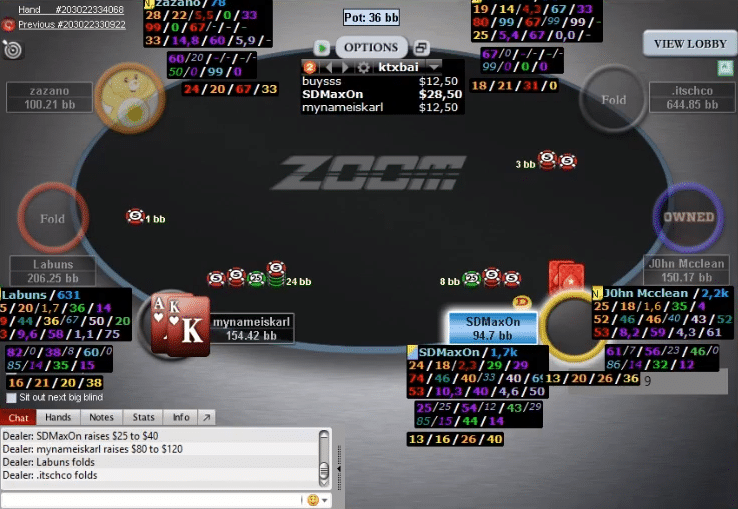
Preflop Analysis
Fried’s 4-betting range should consist of only the super-premium hands (QQ+, AK) because:
- Both of his opponents’ ranges are very tight (especially SDMax).
- He will be forced to play out of position for the rest of the hand.
SDMax’s calling range should be made up of pocket pairs from around 66 and higher, some suited connector type hands, and AQs. He should also elect to call with the strongest hands in the game (QQ+, AK) at some frequency to strengthen and protect his calling range.
Flop
The flop comes: Q♣ 8♥ 7♦
Fried checks, SDMax bets extremely small, $45 big blinds into a $257 pot, and Fried elects to call.
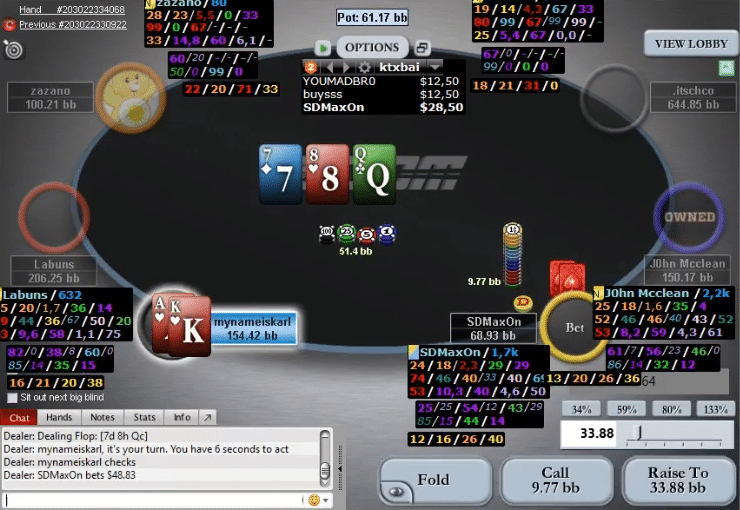
Flop Analysis
Note: I will be using PIOSolver to supplement my analysis in this section.
Before getting into it, I want to remind you that no one can play like a solver in real life, and you shouldn’t try to. We don’t use solvers to try to mirror exactly how they play. We use them as a study tool in order to learn concepts, tactics, and strategies that a human might struggle to come up with on their own.
Keep that in mind while reading this section!
Given that Fried has a significantly stronger range on this board (54% equity), a high-frequency betting strategy is the best play (according to PIOSolver).
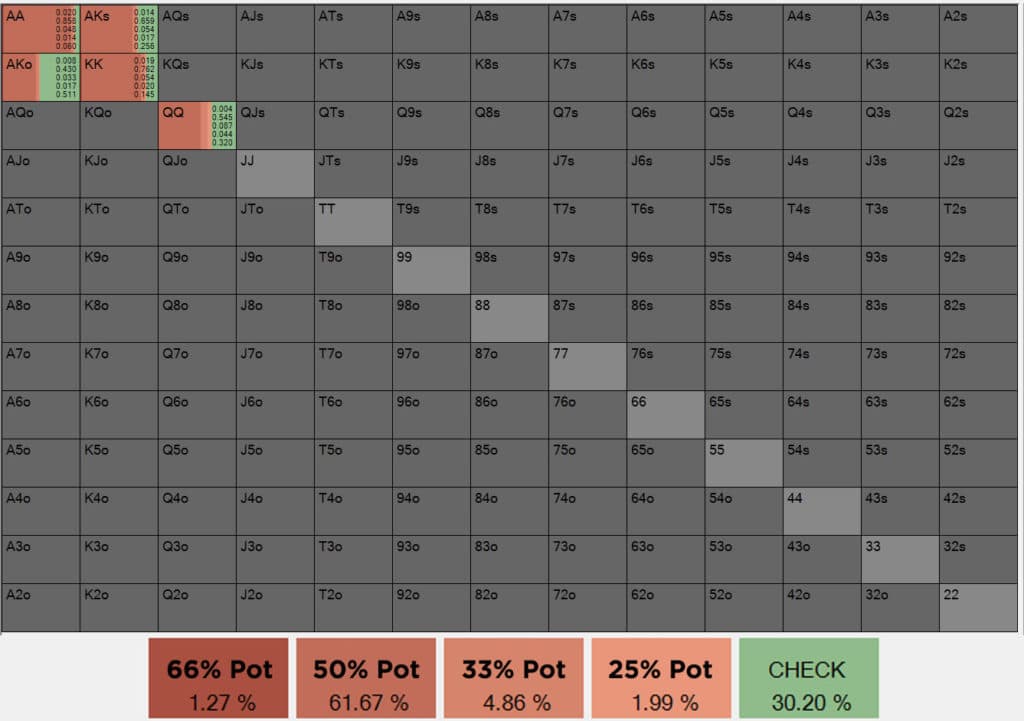
In Fried’s spot, PIOSolver checks at a 30.2% frequency and bets 50% pot at a 61.67% frequency. Other bet sizes are used at low frequencies.
The bet size the solver likes using here is intriguing.
Typically, 25% pot-sized c-bets are preferred in 4-bet pots. However, when given four different bet sizing options (ranging from 25% pot to 66% pot), the solver elects to bet 50% pot.
It’s hard to say for sure why the solver prefers a relatively large size here, but it is likely because Fried’s range is so strong that he wants to put maximum pressure on SDMax’s many marginal hands.
In any case, Fried checks, which can also be fine depending on how he builds the rest of his range. (Since Fried is a boss, he probably builds it well.) In terms of expected value (EV), checking is only a hair worse than betting with a difference of just 0.02 big blinds.
Versus SDMax’s very small ~20% pot bet, the solver decides to raise all-in. This is an amazing and unexpected decision, but it makes sense for a few reasons:
- Fried’s hand has a good amount of equity when called.
- AK blocks SDMax’s value range (AA, KK, AQ).
- AK doesn’t really have any showdown value given how tight SDMax’s range is to begin with.
The solver check-raises with these few combinations of AK suited to balance the QQ combinations that are also check-raised.
Fried decides to call, which is still a +EV decision (as can be seen in the image below).
According to the solver, here is the expected value of each of Fried’s options with A♥ K♥:
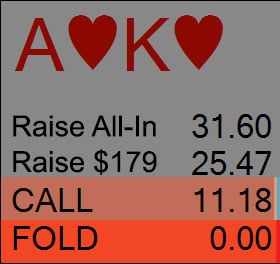
The number on the right is the expected value of each option.
With that lengthy flop analysis out of the way, let’s take a turn.
Turn
The turn is dealt 7♠ and the board is now Q♣ 8♥ 7♦ 7♠.
The action goes check-check.
Turn Analysis
Fried’s check is procedural — he should check with his entire range after check-calling on the flop.
SDMax’s check, on the other hand, gives up some information about the hand that he has. His range is now weighted more towards either a strong made hand, specifically a full house (which can confidently let a free card come off), or a medium strength hand like 99-JJ (which want to get to showdown).
That is not to say that he can’t possibly still have a strong but somewhat vulnerable hand like AA, KK, AQs or KQs, but they are less likely.
River
The river is dealt a 4♣ and the board is now Q♣ 8♥ 7♦ 7♠ 4♣.
Fried shoves all-in for an effective bet of $345 and SDMax folds.
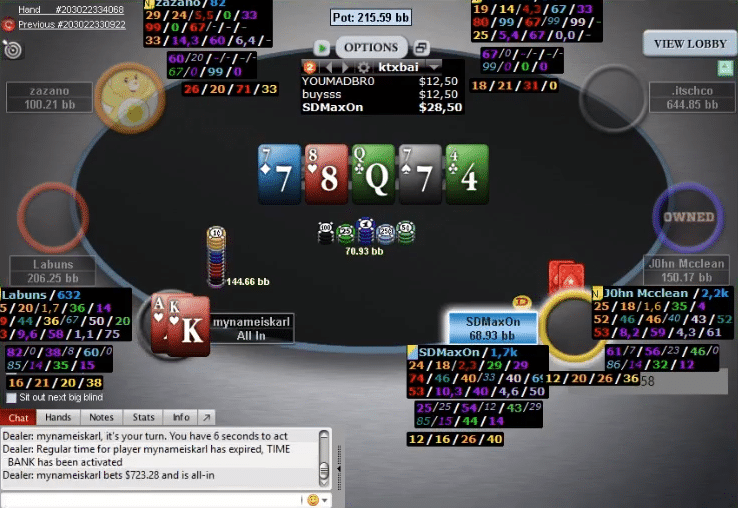
River Analysis
Fried is a peculiar situation because his opponent’s hand almost certainly beats his ace-king high, so by checking he is essentially waving the white flag. There are 2 ways you can approach such a situation:
The theoretical approach is based on your own range. If you take this approach, the main questions you ask yourself are:
- What is my value range?
- How many bluff combos do I need in order to balance it?
- Which hands make the best bluffs? (In Frieds’ hand’s case, AK is his only possible bluff.)
The practical approach simply revolves around whether or not the bluff will be profitable. If you take this approach, you need to use pot odds to figure out how often your bluff needs to work to profit, then decide whether or not your opponent will fold at least that percentage of their range.
In this hand Fried’s shove risks $345 to win the $355 big blind pot, meaning his bluff needs to work…
69 / (69 + 71) * 100 = 49.3% of the time
…in order to break-even. (Learn how to calculate pot odds here.)
You can lean towards one or the other based on how much information you have on your opponent. Without any reads, you are more inclined to lean towards the theoretical view, with reads, you are more inclined to lean towards the exploitative side.
Fried decided to view this spot from a theoretical side and argued his shove by saying that if he doesn’t bluff with this combination, he is not bluffing at all, and went for it.
The solver is not useful in this scenario since it never takes this line.
Final Thoughts
What do you think SDMax folded on the river? Drop your guess in the comments below!
This concludes the series analyzing big pots played by Upswing coach and mid-stakes juggernaut Fried Meulders in a recent $2.50/$5 session.
(If you’re a member of the Upswing Lab and want to see this session in full, go to the Play & Explain section of the course and watch the 3-part series that started on September 27th.)
We have seen him use some small bets in order to put his opponent in a tough spot and extract max value. We have also seen him take big risks in order to push his opponent off of better hands. All of these decisions have been solid at worst and great at best, and he has positive results to show for it.
Understanding how these big pots work will enable you to win a lot more money at the tables, and I hope I was successful in casting some light upon them.
Want to improve your cash game strategy so you can win more money? Take your poker game to the next level by joining the Upswing Lab training course and community. Learn more now!

Good luck, grinders!

